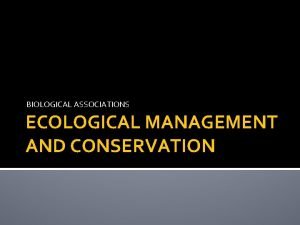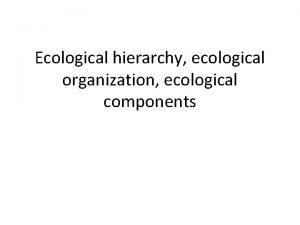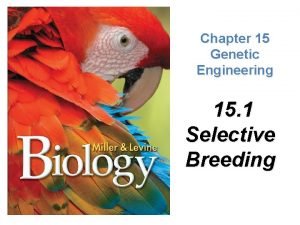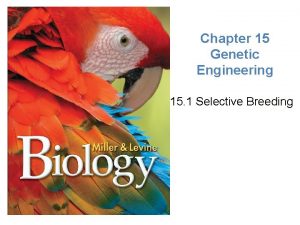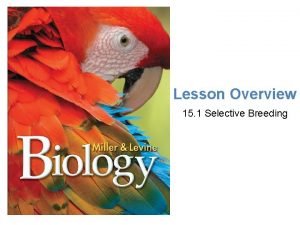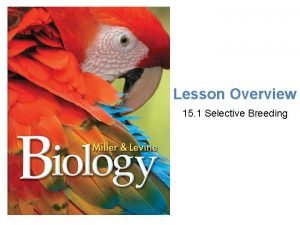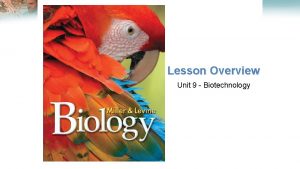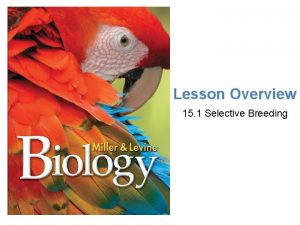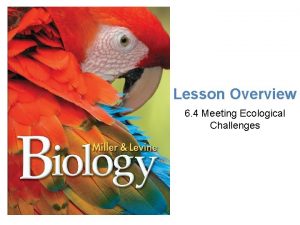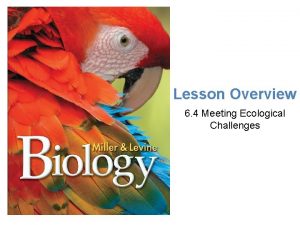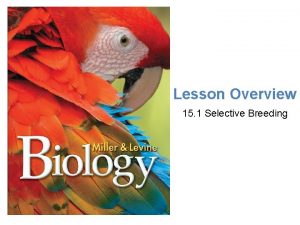Lesson Overview Meeting Ecological Challenges What is genetic














- Slides: 14

Lesson Overview Meeting Ecological Challenges What is genetic engineering? Do Now: What do you know about genetic engineering? HW: Caste learning Genetics due Monday

Lesson Overview Meeting Ecological Challenges Selective Breeding The differences among breeds of dogs are great. Where did these differences come from? Humans use selective breeding to produce animals with certain desired traits. Selective breeding allows only those animals with wanted characteristics to produce the next generation.

Lesson Overview Meeting Ecological Challenges Hybridization American botanist Luther Burbank developed more than 800 varieties of plants using selective breeding methods. hybridization, crossing dissimilar individuals to bring together the best of both organisms. Hybrids—the individuals produced by such crosses— are often hardier than either of the parents.

Lesson Overview Meeting Ecological Challenges Inbreeding To maintain desirable characteristics in a line of organisms, breeders often use inbreeding, the continued breeding of individuals with similar characteristics. The many breeds of dogs are maintained using inbreeding, ensuring that the characteristics that make each breed unique are preserved. Most of the members of a breed are genetically similar, which increases the chance that a cross between two individuals will bring together two recessive alleles for a genetic defect.

Lesson Overview Meeting Ecological Challenges Copying DNA- Extracting DNA using Gel Electrophoresis

Lesson Overview Meeting Ecological Challenges Finding Genes- Southern Blot Analysis

Lesson Overview Meeting Ecological Challenges Combining DNA Fragments If two DNA molecules are cut with the same restriction enzyme, their sticky ends will bond to a DNA fragment that has the complementary base sequence. DNA ligase then joins the two fragments. The resulting molecules are called recombinant DNA.

Lesson Overview Meeting Ecological Challenges Cloning A clone is a member of a population of genetically identical cells produced from a single cell The technique of cloning uses a single cell from an adult organism to grow an entirely new individual that is genetically identical to the organism from which the cell was taken. Clones of animals were first produced in 1952 using amphibian tadpoles. In 1997, Scottish scientist Ian Wilmut announced that he had produced a sheep, called Dolly, by cloning.

Lesson Overview Meeting Ecological Challenges Cloning Animals—Nuclear Transplantation

Lesson Overview Meeting Ecological Challenges GM Crops Since their introduction in 1996, genetically modified (GM) plants have become an important component of our food supply. One genetic modification uses bacterial genes that produce a protein known as Bt toxin. This toxin is harmless to humans and most other animals, but enzymes in the digestive systems of insects convert Bt to a form that kills the insects. Plants with the Bt gene do not have to be sprayed with pesticides. In addition, they produce higher yields of crops.

Lesson Overview Meeting Ecological Challenges GM Animals Transgenic animals are becoming more important to our food supply. About 30 percent of the milk in U. S. markets comes from cows that have been injected with hormones made by recombinant-DNA techniques to increase milk production. Pigs can be genetically modified to produce more lean meat or high levels of healthy omega-3 acids. Using growth-hormone genes, scientists have developed transgenic salmon that grow much more quickly than wild salmon.

Lesson Overview Meeting Ecological Challenges Treating Disease Gene therapy is the process of changing a gene to treat a medical disease or disorder. In gene therapy, an absent or faulty gene is replaced by a normal, working gene. This process allows the body to make the protein or enzyme it needs, which eliminates the cause of the disorder.

Lesson Overview Meeting Ecological Challenges Genetic Testing Genetic testing can be used to determine if two prospective parents are carrying the alleles for a genetic disorder such as cystic fibrosis (CF). Because the CF allele has slightly different DNA sequences from its normal counterpart, genetic tests use labeled DNA probes that can detect and distinguish the complementary base sequences found in the disease-causing alleles.

Lesson Overview Meeting Ecological Challenges Forensic Science The precision and reliability of DNA fingerprinting has revolutionized forensics—the scientific study of crime scene evidence. DNA fingerprinting has helped solve crimes, convict criminals, and even overturn wrongful convictions.
 Founder effect
Founder effect Genetic programming vs genetic algorithm
Genetic programming vs genetic algorithm Genetic programming vs genetic algorithm
Genetic programming vs genetic algorithm Genetic drift vs genetic flow
Genetic drift vs genetic flow Genetic drift vs genetic flow
Genetic drift vs genetic flow Ecological association in biology
Ecological association in biology Today meeting or today's meeting
Today meeting or today's meeting Meeting objective
Meeting objective What is meeting and types of meeting
What is meeting and types of meeting Types of meeting
Types of meeting Chapter 9 lesson 2 photosynthesis an overview
Chapter 9 lesson 2 photosynthesis an overview Lesson overview
Lesson overview Toward civil war lesson 3 secession and war
Toward civil war lesson 3 secession and war The federalist era lesson 2 early challenges
The federalist era lesson 2 early challenges Chapter 25 lesson 1 health
Chapter 25 lesson 1 health





